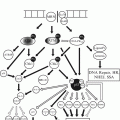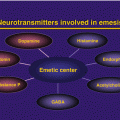Grade
Category
Estimated incidence (%)
Definitiona
0
Asymptomatic
10
Radiographic superior vena cava obstruction in the absence of symptoms
1
Mild
25
Edema in head or neck (vascular distention), cyanosis, plethora
2
Moderate
50
Edema in head or neck with functional impairment (mild dysphagia, cough, mild or moderate impairment of head, jaw or eyelid movements, visual disturbances caused by ocular edema)
3
Severe
10
Mild or moderate cerebral edema (headache, dizziness) or mild/moderate laryngeal edema or diminished cardiac reserve (syncope after bending)
4
Life-threatening
5
Significant cerebral edema (confusion, obtundation) or significant laryngeal edema (stridor) or significant hemodynamic compromise (syncope without precipitating factors, hypotension, renal insufficiency)
5
Fatal
<1
Death
35.6.2 Imaging: Staging
The diagnosis of a SVCS can be made on a chest radiograph. The most important finding is widening of the right side of the superior mediastinum. Pleural exudative effusion on the right side may occur. A chest computed tomogram (CT) with intravenous contrast medium in the venous phase can be used for the diagnosis of tumor mass size, its localization and SVC diameter and length of SVC stenosis. CT can be useful for the planning of endovascular treatment.
Magnetic resonance imaging (MRI) with MRI phlebocavography and phlebocavography with intravenous contrast injection can be performed. Angiography with syncronous venous pressure gradient measurements and stenting can be carried out. For patients with no known history of malignancy invasive methods, including bronchoscopy, percutaneous needle biopsy, mediastinoscopy, and thoracotomy, can be applied. Biopsies with histological and/or cytological examination can rule out benign causes and determine a specific diagnosis to direct the most appropriate treatment.
Bronchoscopy, can detect endoluminal tumor growth, infiltration of central and peripheral airways, obtain neoplastic tissue or cytological samples with the use of brush, bronchial washing, or bronchoalveolar lavage.
Endobronchial ultrasound and real-time convex-probe endobronchial ultrasound (CP-EBUS)-guided transbronchial needle aspiration (TBNA) offers an alternative and less invasive diagnostic modality for biopsy of mediastinal lymph nodes [10].
Newer techniques of mediastinoscopy such as video-assisted mediastinoscopic lymphadenectomy (VAMLA) and transcervical extended mediastinal lymphadenectomy (TEMLA) allow better visualization and more extensive sampling of mediastinal nodes with the surrounding fatty tissue and can be combined with minimally invasive video-assisted lobectomy [11, 12].
Positron emission tomography provides additional information on nodal status and mediastinal involvement.
35.6.2.1 Treatment
Head elevation to decrease head and neck edema and hydrostatic pressure is recommended. Intramuscular and intravenous injections in the upper extremities should be avoided because due of the slow venous return, delayed absorption of drugs from the surrounding tissues can caused thrombosis of veins and irritation. Glucocorticoids are recommended in patients with steroid-sensitive tumors such as lymphoma to thymoma and in patients undergoing radiotherapy to prevent swelling. In patients with preexisting laryngeal edema, steroids might be justified.
Diuretics with a low-salt diet are recommended, although it is unclear whether small changes in right atrial pressure affect venous pressure distal to the obstruction. If SVCS results from an intravascular thrombus associated with an indwelling catheter, catheter removal and systemic anticoagulation should be combined in order to prevent embolization [1]. If SVCS detected early, can be treated by fibrinolytic therapy without sacrificing the catheter [13].
Stay updated, free articles. Join our Telegram channel

Full access? Get Clinical Tree





